GCRA WHITE PAPER
HOW MUCH FASTER CAN BIOROCK INCREASE CORAL GROWTH?
Thomas J. F. Goreau
December 10 2023
Record fast coral growth enhancement under Biorock electrical stimulation of up to 4.126 times faster in diameter, 20.7488 times faster in length, and 353.225 times faster growth by volume than control corals (average values only reported, extremes were higher) has been reported for Acropora corals in Java, Indonesia (Nugroho, Zuhry, Kusnandar, Simanjuntak, Alamsyah, & Karissa, 2023, Biorock® Technology Application To The Growth And Acropora Corals Growth Rate, IOP Conf. Ser.: Earth Environ. Sci. 1147 012003 DOI 10.1088/1755-1315/1147/1/012003), https://www.globalcoral.org/biorock-corals-grow-more-than-20-times-faster/.
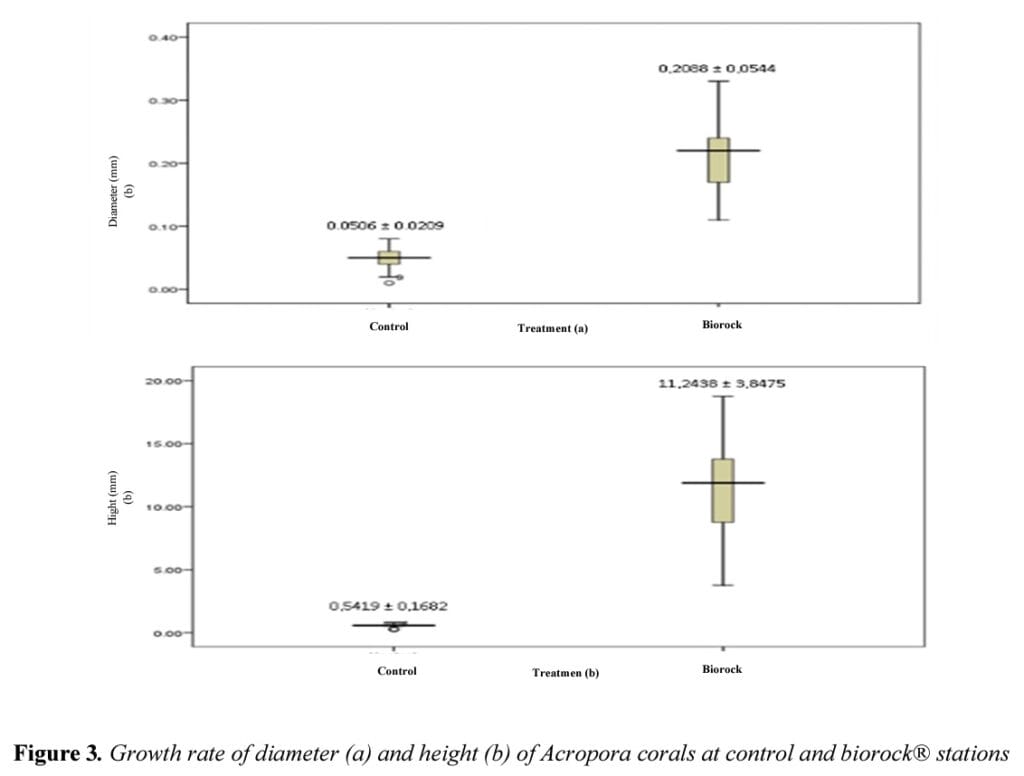
Growth rate of Acropora fragment diameter (top) and length (bottom), from Java, Indonesia, by Nugroho et al., 2023.
A 2014 review of 16 separate Biorock growth enhancement of corals, oysters, and gorgonians (T. J. Goreau, 2014, Electrical stimulation greatly increases settlement, growth, survival, and stress resistance of marine organisms, Natural Resources, 5:527-537 http://dx.doi.org/10.4236/nr.2014.510048) reported mean linear Biorock growth enhancements of 3.16 times controls, but ranging up to 12 times higher, with 3-5 times enhancement most common for most species measured under field operating conditions.
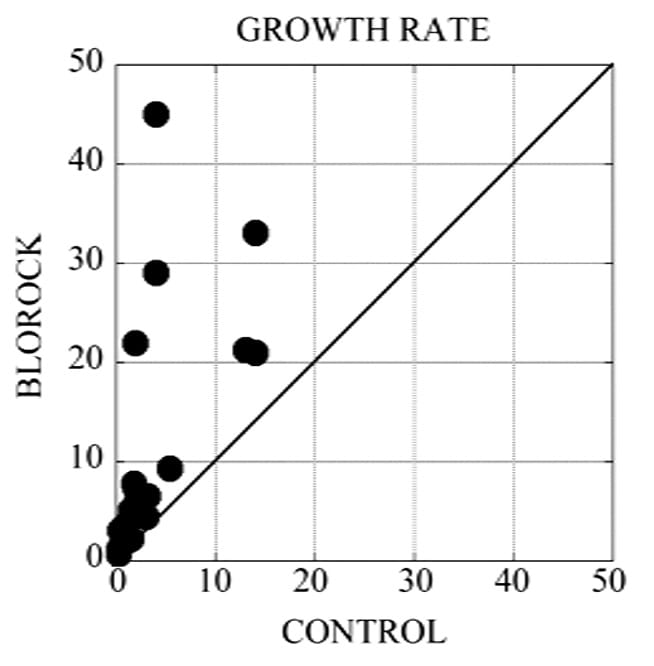
Growth rate of corals, oysters and gorgonians on Biorock compared to controls. Each dot indicates a different species at a different location under different conditions. From Goreau, 2014.
Similarly accelerated growth rates to those found by Nugroho et al. have been reported for other species of corals at other sites in Indonesia (Jompa, Suharto, Anpusyahnur, Dwija, Subagio, Alimin, Anwar, Syamsuddin, Heni, Radiman, Triyono, Sue, and Soeyasa, 2013, Electrically stimulated corals in Indonesia reef restoration projects show greatly accelerated growth rates, and Bakti, Virgota, Damayanti, Radiman, Retnowulan, Hernawati, Sabil, and Robbe, 2013, Biorock reef restoration in Gili Trawangan, North Lombok, Indonesia, both in Goreau & Trench (Editors), Innovative Methods of Marine Ecosystem Restoration, CRC Press, Boca Raton)
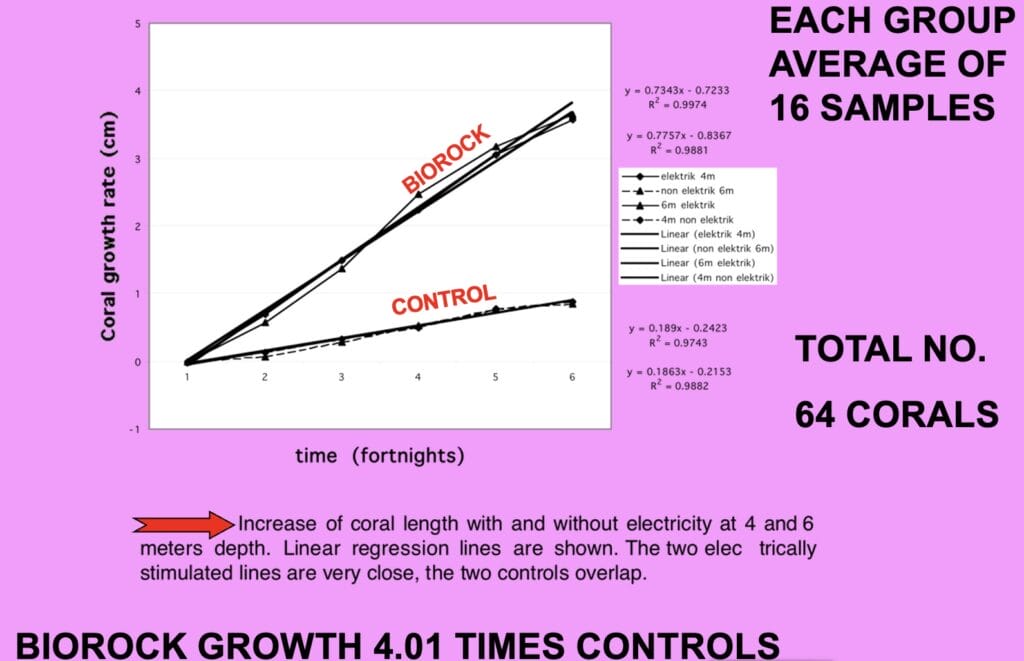
The first Biorock length measurements on Acropora showed 4.01 times faster growth, but it was later realized that the controls were close enough that they were also being stimulated by the Biorock process. Data from Putra Nyoman Dwija, Udayana University.
A typical example, from Gili Trawangan, Lombok, Indonesia is shown:
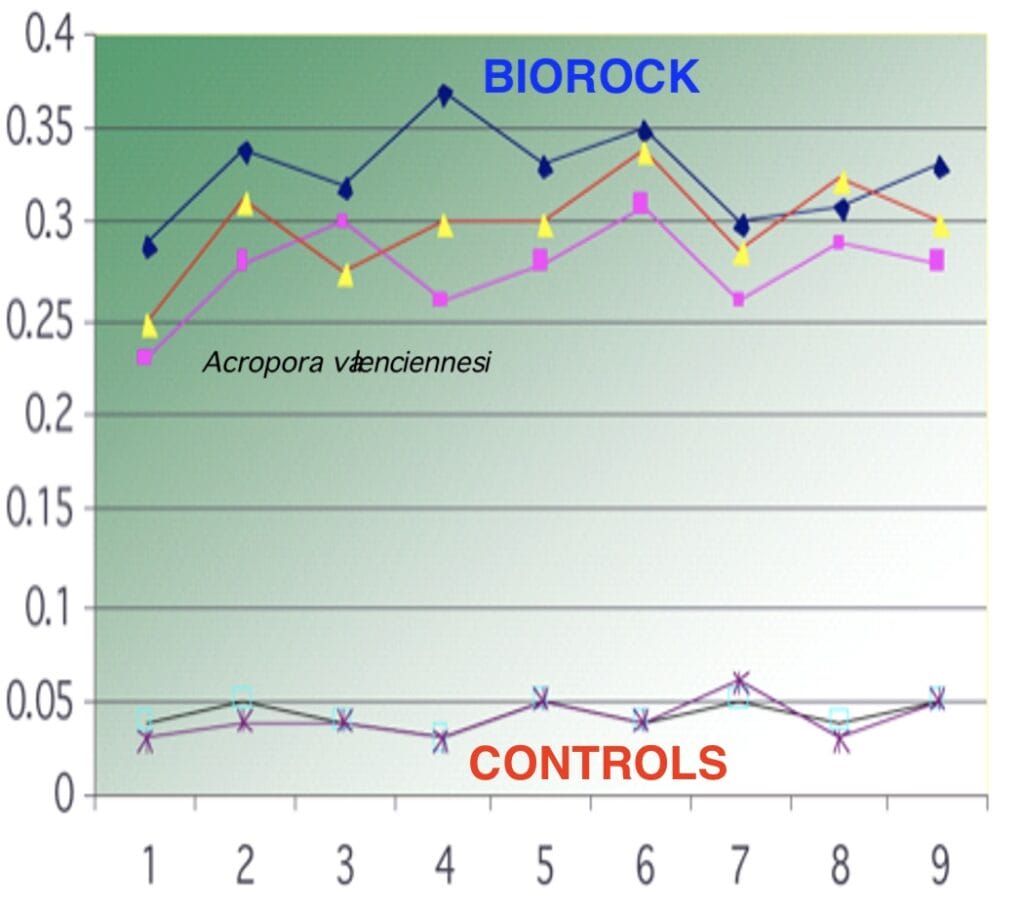
Coral linear growth rate in centimeters per week over 9 weeks. X symbols are unpowered controls, filled symbols are on Biorock reefs at Gili Trawangan, Lombok, Indonesia. Measurements by Rosihan Anwar. Under these conditions Biorock increased growth rate around 10-12 times.
Natasasmita, Wijayanti, & Suryono, 2016, The effects of electrical voltage differences and initial fragment size on growth performance and survival rate of coral Acropora cerealis in Biorock method, Journal of Aquaculture and Marine Biology: 4 (4): 0086. DOI: 10.15406/jamb.2016.4.00086), found that Biorock corals grew in length by up to 14.67 times faster in length in Bali, Indonesia depending on coral fragment starting size and power.
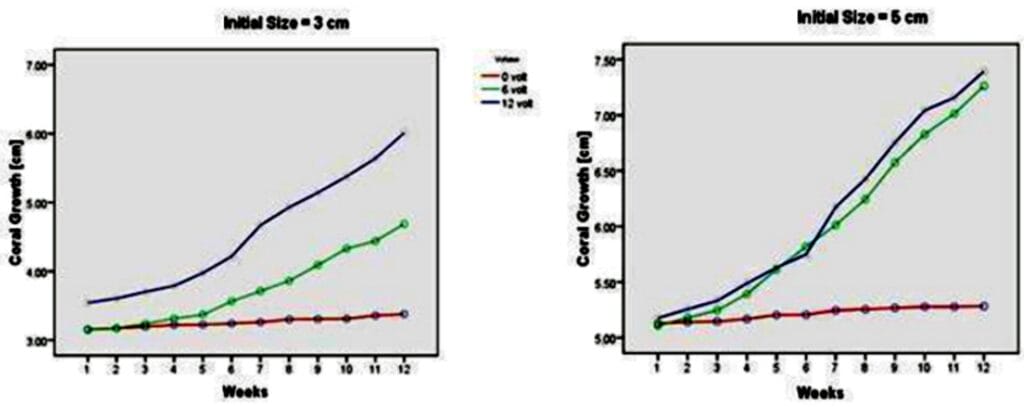
Coral length (centimeters) for Acropora fragments under higher power (blue), lower power (green), and controls (red) for starting sizes of 3 cm (left) and 5 cm (right) in Pemuteran, Bali, Indonesia. From Natasasmita et al., 2016.
In contrast lower growth enhancement of length and thickness, of around 3-5 times was found for Pocillopora and Acropora in Sumatra, Indonesia (Munandar, Mahendra, Rizal, Rani, & Faizal, 2018, The escalation of coral growth by Biorock technology applied in Sabang marine ecotourism, AACL Bioflux, 11:1633-1647). https://www.globalcoral.org/biorock-corals-grow-faster-longer-and-wider-depending-on-species-and-depth/
The first aquarium hobbyist to use Biorock on corals reported that staghorn Acropora growth was accelerated around 15 times to “incredible and stupefying” rates, with corals growing out of the tank! Unfortunately, the person who reported this on an aquarium hobbyist web site did not respond to our requests to provide photographs and data to validate his claims, but as this report shows, this un-confirmable claim is well within the range of coral growth enhancement reported for studies on Biorock reefs in the ocean in Indonesia.
Biorock oysters at a former Superfund toxic waste site in New York City were found to grow 9.30 times faster in length than controls during the summer growing season, continued to grow all winter long without entering normal winter dormancy of around 6 months. (Cervino, Weeks, Shor, Lin, Gjoza, & Goreau, 2013, Electrical restoration of oysters and saltmarsh at a New York City estuarine wetland, International Conference on Shellfish Restoration, Mystic, Connecticut); J. Shorr, J. Cervino. C. Lin, R. Weeks, & T. J. Goreau, 2013, Electrical stimulation increases oyster growth and survival in restoration projects, in T. J. Goreau & R. K. Trench (Editors), Innovative Technologies for Marine Ecosystem Restoration, CRC Press). The oysters grew proportionately wider and thicker as they grew longer, so grew 804.357 times faster by volume with Biorock.
Biorock remains the best technology for regenerating Indonesian coral reefs and fisheries, not only because of the great increase in growth, survival, and biodiversity, but also because it is the only method that increases coral survival from severe bleaching. Conventional fragmentation methods do well as long as water quality is excellent, but suffer near complete mortality when the water becomes too hot, muddy, or polluted (T. J. Goreau, 2010, Coral reef and fisheries habitat restoration in the Coral Triangle: the key to sustainable reef management, Invited Keynote Talk, World Ocean Congress, Manado, Sulawesi, Indonesia, in J. Jompa, R. Basuki, Suraji, M. Tesoro, & E. T. Lestari (Eds.) Proceedings of the COREMAP Symposium on Coral Reef Management in the Coral Triangle, p. 244-253).
It is still not known what differences between species, site environments, and electrical conditions account for the differences in results, and much more work is needed to optimize results. At present around 20 times linear growth acceleration seems to be the experimentally derived upper limit under field conditions, but it is possible that it could be further increased with the right environmental and electrical conditions.
The growth rate of each coral is a complicated function of many local environmental factors, as well as of the electrical conditions. Under the typical conditions of Biorock reefs grown in the field for coral reef regeneration and shore protection, a coral growth increase of 3-5 times is typical, but values of 10-20 times enhancement by the Biorock process are not uncommon. More research is needed to find the optimal conditions for the widest range of reef species. Since Biorock is the only method known to save corals from severe bleaching mortality, it is critically urgent to do this research before coral reefs die from global warming. There is very little time left!:
https://www.globalcoral.org/cop28-coral-reef-extinction-from-global-warming-requires-reparations-from-fossil-fuel-producers/